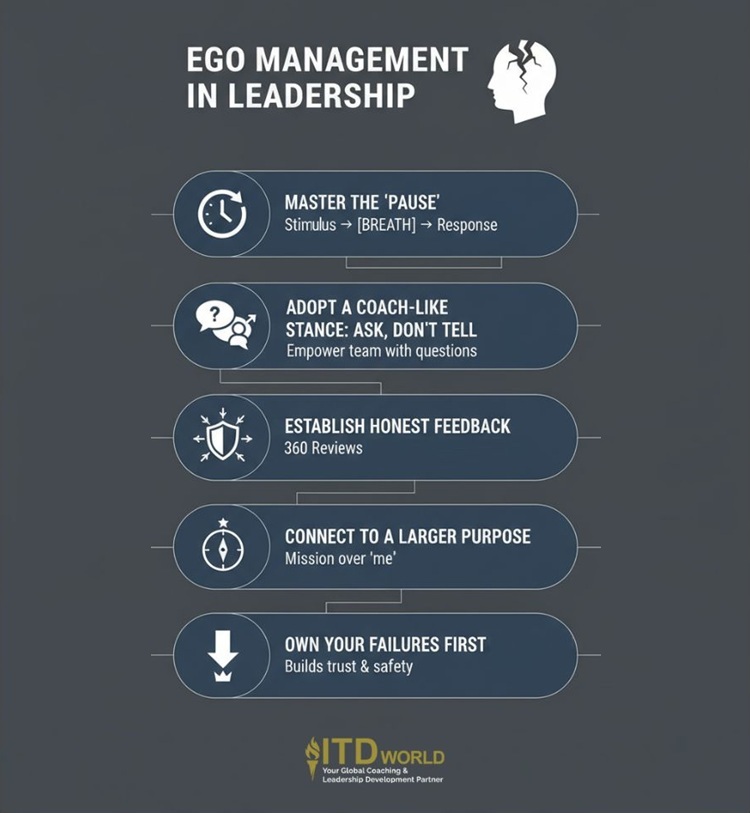A practical playbook for managing ego in leadership and cultivating the foundation necessary to lead with lasting, positive impact.
While it may seem counterintuitive, one of the biggest obstacles to a leader’s continued success is their past success itself. Success feeds the ego, and an unchecked ego – one that resists feedback, avoids vulnerability, and prizes being “right” over being effective – is the single greatest barrier to learning, listening, and leading. For those who wish to advance sustainbly to greater heights – to move from “here” to “there” – learning to tame that inner voice, to manage ego in leadership, is crucial.
|
Author: Jonathan M. Pham |
Highlights
- Ego is a two-sided coin: A healthy ego is based on self-awareness and proven ability, inspiring action. An unhealthy one stems from insecurity and a defensive need to be superior, ultimately eroding trust and stifling growth.
- Unhealthy ego manifests in destructive “Ego Traps”: These common behaviors include the need to be the “Smartest person in the room,” the inability to receive feedback defensively, prioritizing “Me” over “We” (taking credit for wins, blaming others for failures), and the fear of looking weak (hiding mistakes or uncertainty).
- Effective leadership requires proactive ego management: Strategies include mastering the “pause” before reacting, adopting a coach-like stance by asking questions instead of giving all the answers, actively seeking and establishing systems for honest feedback, connecting to a larger purpose, and owning failures first and loudest.
Ego in Leadership: Confidence vs. Arrogance
For any leader, the ego is a two-sided coin. The goal is not to eliminate it completely (after all, it is a source of one’s identity and drive), but to manage it. This requires one to first understand the difference between a healthy ego and an unhealthy, over-inflated one.
- A healthy ego (Confidence) stems from genuine self-awareness, self-respect, and proven ability. It is the inner belief that allows one to be decisive, take bold but calculated risks, and remain resilient in the face of uncertainty or a crisis. This is the “I can” belief that inspires a team to act.
- An unhealthy ego (Arrogance), in contrast, is rooted in insecurity. It manifests as a deep, defensive need to be perceived as superior, right, or infallible at all times. This “I am better than” mindset, if left unchecked, is what erodes trust and stifles growth over time.
| Feature | Healthy Ego (Confidence) |
Unhealthy Ego (Arrogance)
|
| Origin | Self-Awareness & Ability |
Insecurity & Fear
|
| Focus | Achieving the mission (“What is right?”) |
Protecting status (“Who is right?”)
|
| Response to feedback | Listens with curiosity |
Reacts with defensiveness
|
| View of others | A resource to learn from |
An audience to perform for
|
While unfortunate, the truth is that unhealthy ego is a pervasive but often under-discussed element in leader-follower dynamics. Research, such as Elizabeth Scales’ MBA dissertation from the National College of Ireland, has revealed that this ego often manifests subtly, influencing decision-making, distorting communication, and eroding team morale across all industries.

Ego leadership approach
How Does Ego Affect Leadership? The Four “Ego Traps”
Having distinguished between healthy confidence and destructive arrogance, let us now look at the specific ways the unhealthy ego manifests in a leader’s daily behavior. Below are the “ego traps” – common, predictable patterns that, while often stemming from one’s past achievements, will inevitably sabotage their future growth and their team’s performance.
-
The “Smartest person in the room” syndrome
This is the belief that a leader’s value comes from having all the answers. The ego-driven manager dominates discussions, forces their own opinions, and treats their team’s opinions as a challenge to their authority. They are more interested in being right than in getting the best outcome.
Example: In a brainstorming meeting, this leader presents their own idea first and then spends the rest of the time defending it against other suggestions. The team quickly learns that their ideas aren’t genuinely wanted, and they stop sharing them.
As you may see from the example above, this “Smartest person in the room” behavior is the fastest way to kill psychological safety and innovation.
-
The inability to receive feedback
The unhealthy ego views constructive feedback as a personal attack on its competence or character. When presented with a differing viewpoint or criticism, the leader’s first instinct is to become defensive, make excuses, or even blame the person giving the input.
Example: A direct report offers a well-intentioned, data-backed suggestion for how a process could be improved. The ego-driven leader interrupts, explains at length why the current process is correct, and implies the employee doesn’t see the “big picture.” The direct report learns that honesty is punished and never presents candid feedback again, leaving the leader to operate in an echo chamber of their own making.
“Let me explain why that won’t work” is unique because it is pure unadulterated negativity under the guise of being helpful. We employ it (or its variations such as “The only problem with that is . . .”) to establish that our expertise or authority is superior to someone else’s. It doesn’t mean that what we say is correct or useful. It’s simply a way of inserting ourselves into a situation as chief arbiter or senior critic. The only problem with that (to coin a phrase) is how little we like or respect our critics. They’re annoying. And over time, we treat them as if they’re carrying avian flu. We avoid them. We stop working with them. We refuse to help them.
Marshall Goldsmith, ‘What got you here won’t get you there’
-
The focus on “Me” over “We”
This happens when one prioritizes personal status and visibility over collective success. As such, one becomes quick to take the spotlight for wins and just as quick to “pass the buck” or assign blame for failures.
Example: When presenting a successful project to senior executives, the ego-driven leader uses “I” to describe the key breakthroughs (“I decided to pivot the strategy,” “I implemented the new system”). When a project fails, they say, “The team failed to execute.” Their self-serving behavior destroys team trust and breeds a culture of self-preservation.
-
The fear of looking weak
The unhealthy ego’s tendency is to mistake vulnerability for weakness. It causes one to assume that one must always appear perfect, strong, and in complete control. This fear prevents them from doing three critical things: asking for help, admitting mistakes, or saying “I don’t know.”
Example: A leader, feeling overwhelmed and unclear on the path forward, will hide this reality from their team. Instead of acknowledging, “I’m not sure what the right next step is, let’s work on this together,” they project false confidence or micromanage the process to maintain an illusion of control. In doing so, they allow no room for authentic connection and rob the team of the opportunity to engage in collaborative problem-solving.
Read more: Ego in the Workplace – The Hidden ‘Evil’ Behind Team Dysfunctions

Ego in management
Ego Management in Leadership: A 5-step Blueprint
Before you are a leader, success is all about growing yourself. When you become a leader, success is all about growing others.
Jack Welch
Overcoming the above-mentioned four ego traps requires a disciplined, active practice of cultivating humility. Below are five core strategies that leaders may leverage to better tame their inner voice and lead with greater impact.
-
Master the “pause”
This is the most fundamental and immediate tactic. The “pause” is the small space of time one creates between a stimulus (like a criticism or a setback) and their response.
Why it works: An ego-driven reaction is almost always emotional and defensive. It’s the “fight or flight” response for one’s status. By taking a deliberate breath before speaking or replying, you create the mental space to compose yourself and consciously adopt a more considered and objective response (e.g. when a team member challenges your idea, you reply with something like, “That’s an interesting point. Tell me more about your concern.”)
Read more: Mindful Leadership – Slow Down to Move Forward
-
Adopt a coach-like stance: Ask, don’t tell
A coach-like stance serves as the direct antidote to the “smartest person in the room” syndrome. It involves one intentionally shifting their default mode from giving solutions (which feeds the ego) to asking powerful questions (which empowers the team).
Why it works: Doing so signals that you value collective intelligence over your own. It fosters critical thinking and a sense of ownership within the team.
Example: Instead of starting a problem-solving meeting by saying, “Here is the plan,” one should ask, “What is the biggest obstacle we face here, and what are your ideas for how to tackle it?”
Read more: Leadership Potential – How to Spot & Cultivate Future Leaders
-
Establish a system for honest feedback
The unhealthy ego thrives in an echo chamber. A humble leader, by contrast, actively seeks the truth as the only solution to their own blind spots.
Why it works: You cannot manage something you cannot see. Proactively seeking feedback forces you to confront objective reality, which is the best way to keep your ego in check.
Example: This goes beyond just having an “open-door policy.” It means using formal tools like 360-degree feedback to get structured, objective data. It also means informally finding an “accountability partner” – a trusted peer or coach/ mentor – and giving them explicit permission to call you out when they see your ego driving a decision.
Read more: Leadership Self-reflection – Leading with Clarity
-
Connect to a larger purpose
This strategy shifts one’s focus from themselves to their mission, effectively starving the ego of the attention it craves. It directly counters the “me over we” trap.
Why it works: When a leader is genuinely motivated by a purpose larger than themselves (e.g., serving the customer, developing their people), their personal ego naturally takes a back seat.
Example: When faced with a difficult decision, one may change their internal monologue from, “How does this decision make me look?” to, “Which decision best serves our team’s objective?”
Read more: Leadership Philosophy – How to Define Your True North & Follow It
-
Own your failures first and loudest
This is the most powerful and visible way to overcome the “fear of looking weak” and “me over we” traps. Being the first to own one’s part in a failure is a profound display of confidence, accountability, and integrity. It instantly builds trust and creates psychological safety for the entire team, making it safe for others to admit their own shortcomings.
Example: When a deadline is missed, instead of questioning “Who dropped the ball?”, one should say, “I clearly didn’t build in enough buffer time for this project, and I own that. Let’s analyze what we can learn from it and create a new plan.”
Read more: Leading by Example – Key to Truly Inspiring Action & Trust

How to overcome egocentrism in leadership
Case Studies of Ego in Leadership
When the ego dominates in organizations, even spiritual organizations, there is usually a big drama or upheaval of some kind, and self-destruction begins.
Eckhart Tolle
The impact of an unmanaged ego is not just theoretical; it is written in the hard-won lessons of business and history.
#1: The brilliant mind derailed by ego
A classic historical example is Napoleon Bonaparte. A military strategist of unparalleled genius, his early successes were historic. However, as his power and empire grew, Napoleon began to believe in his own infallibility, and he increasingly ignored the candid input of his most experienced generals.
Eventually, it led to his own downfall – which culminated in his disastrous 1812 invasion of Russia. Despite his generals’ warnings about the brutal Russian winter and an over-extended supply line, Napoleon would not retreat or heed their counsel. He believed his own genius could overcome any obstacle. The result? The loss of his army and, ultimately, his empire.
In the end, brilliance and strategy were no match for an unchecked ego.
#2: Taming the ego for a legendary comeback
A modern business example is the journey of Steve Jobs. In his first tenure at Apple, Jobs was famously brilliant but also notoriously arrogant, combative, and ego-driven. His inability to collaborate – coupled with his conviction that his way was the only way – were key factors in his ousting from the company in 1985.
- The change: Jobs’ “wilderness” years – founding NeXT and investing in Pixar – served as a profound lesson in humility. He was forced to be open to and rely on others in new ways.
- The return: When he came back to to a failing Apple in 1997, he was still intense and demanding, but his leadership style had evolved. He built a small, trusted team of A-players, like Jony Ive and Tim Cook, and shifted his focus from being right to achieving the best result. He channeled his passion into a larger purpose (the product) rather than just his personal ego, enabling the deep collaboration that led to the iMac, iPod, iPhone, and ultimately one of the most famous corporate comebacks in history.
As demonstrated in Jobs’ story, ego is something that can be tamed for the greater good. By learning to work with and trust a team of experts, Jobs transformed his biggest liability into his greatest strength.
Read more: Leader vs Boss – 11 Key Differences (Which One Are You?)

Ego in business
Ego in Leadership Quotes
More the knowledge lesser the ego, lesser the knowledge more the ego.
Albert Einstein
Why do you think that great leaders and thinkers throughout history have “gone out into the wilderness” and come back with inspiration, with a plan, with an experience that puts them on a course that changes the world? It’s because in doing so they found perspective, they understood the larger picture in a way that wasn’t possible in the bustle of everyday life. Silencing the noise around them, they could finally hear the quiet voice they needed to listen to.
Ryan Holiday
The greatest leaders are those who are willing to listen and learn, knowing that their ego is their greatest enemy.
Leaders must be willing to put the ship’s performance ahead of their egos.
Michael Abrashoff
Less me + More them = Success.
Marshall Goldsmith
Managing our ego’s craving for fortune, fame, and influence is the prime responsibility of any leader.
Jennifer Woo, CEO and chair of The Lane Crawford Joyce Group
A man who wants to lead the orchestra must turn his back on the crowd.
Max Lucado
We come nearest to the great when we are great in humility.
Rabindranath Tagore
Leaders, whatever field they work in, have a strong impact on people’s lives and on how the world develops. We should remember that we are visitors on this planet. We are here for 90 or 100 years at the most. During this time, we should work to leave the world a better place.
Dalai Lama
For those who have conquered the mind, it is their friend. For those who have failed to do so, the mind works like an enemy.
Bhagavad Gita 6.6
Those who know don’t talk. Those who talk don’t know.
Lao Tzu
Whoever would be first among you must be servant of all.
Matthew 20:26
Those who exalt themselves will be humbled, and those who humble themselves will be exalted.
Luke 14:11
Ego in Leadership Books
- Ego Free Leadership – Brandon Black & Shayne Hughes
- Focuses on how unconscious ego-driven behaviors sabotage organizations.
- Discuss practical strategies to recognize and dismantle destructive patterns.
- Based on real corporate case studies, including the authors’ own leadership journeys.
- Ego Is the Enemy – Ryan Holiday
- A modern classic that argues ego is the greatest obstacle to success.
- Features historical and contemporary examples to show how humility, discipline, and purpose lead to achievement.
- Particularly relevant for those who struggle with pride after success.
- Good to Great – Jim Collins
- While not solely about ego, it highlights how “Level 5 Leaders” succeed by combining fierce resolve with deep humility.
- Shows that ego-driven leaders rarely sustain greatness.

Ego is the enemy of good leadership
How ITD World Can Help
Taming the ego is arguably the most advanced and personal work a leader can undertake. It is a challenging, continuous journey that requires courage, vulnerability, and deep self-awareness. Because it is so difficult to realize one’s own blind spots, this is a journey best walked with a trusted, objective partner.
At ITD World, we specialize in providing the expert, confidential support leaders need to acquire this crucial capability. Our training solutions are designed to provide a safe and effective mirror, allowing one to see oneself clearly and cultivate the humility that drives high performance.
- Executive coaching: This is the most powerful tool for ego management. Our world-class coaches provide a confidential, one-on-one partnership. They act as a trusted partner, helping you process feedback, identify your shortcomings, and adopt the behaviors required for authentic leadership.
- 360-degree feedback: We provide and facilitate the 360-degree assessment process, which gathers the objective data needed to break through an ego’s defenses and gain an unvarnished view of one’s impact on others.
- Leadership workshops: Our programs focused on Emotional Intelligence (EQ), Humility, and other leadership skills are designed to nurture the underlying competencies of self-regulation and empathy – the natural antidote to a destructive ego.
Ready to transform your biggest obstacle into your greatest strength? Contact ITD World today to learn how our coaching & training solutions can help!
Other resources you might be interested in:
- The Power of Apology: How to Say Sorry as a Leader
- Human Centered Leadership: The Importance of a ‘People First’ Mindset
- Gratitude in Leadership: From Words to Actions
- Spiritual Leadership: A Remedy for Today’s Workplace Woes
- Love Leadership: More Than an Abstract Philosophical Idea

